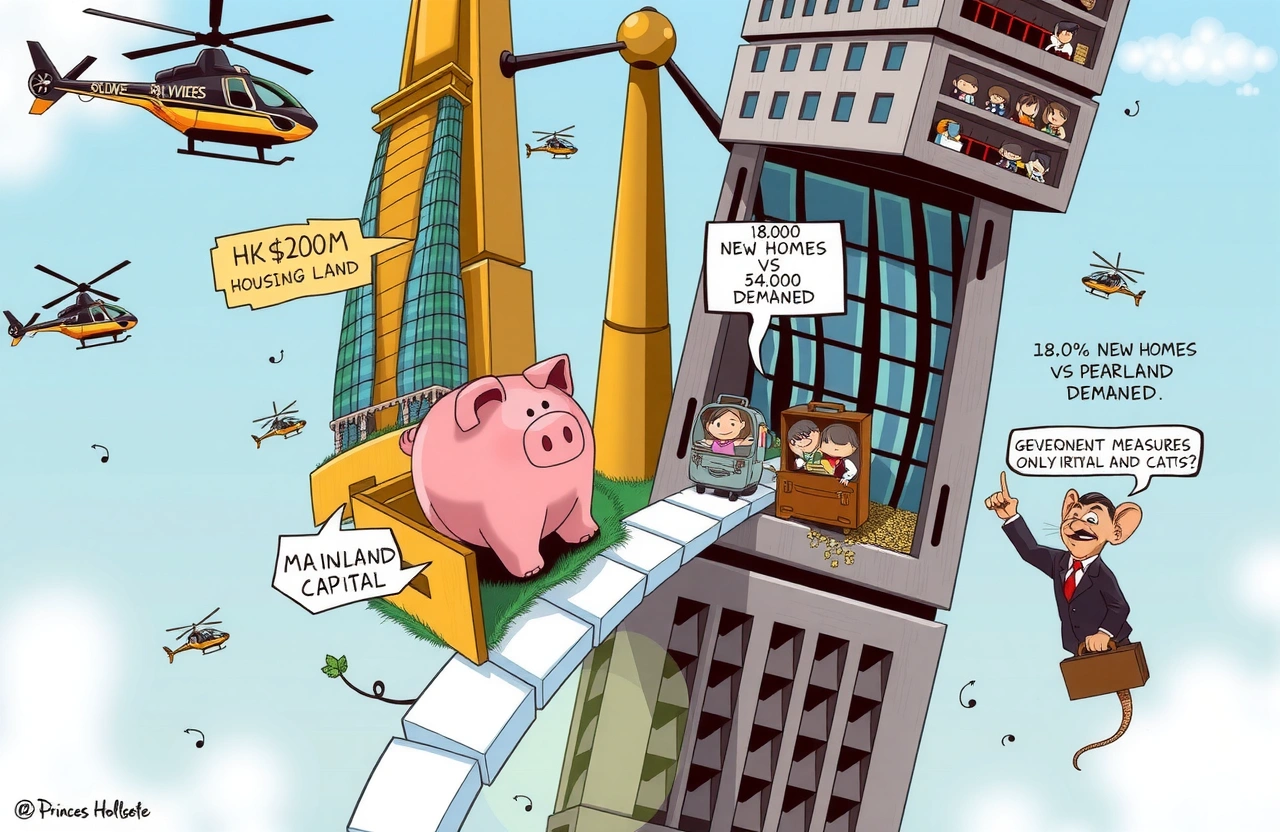When Logic Meets Luxury: Hong Kong’s Property Paradox
Against all economic forecasts and global recession warnings, Hong Kong property prices continue their stratospheric ascent. This concrete jungle where land commands higher prices than Manhattan has baffled analysts by hitting record highs quarter after quarter. The average price per square foot for luxury residential units now exceeds USD 4,000, creating a real estate universe where gravity applies to everything except this market. What sorcery allows such defiance? The answer lies in a perfect storm of territorial limitations, investment inflows, and policy mechanisms that force us to rewrite real estate economics textbooks.
The Mechanics of Market Defiance
Hong Kong property operates on fundamental principles that override conventional economic theories. The city’s improbable trajectory stems from unique structural factors impossible to replicate elsewhere.
Crucial Demand Drivers
Several forces combine to fuel the relentless demand for Hong Kong property:
– Limited developable land supply across Hong Kong’s mountainous terrain
– Steady influx of mainland Chinese capital seeking safe assets
– Global institutional funds designate Hong Kong property as prime portfolio allocation
– Low property tax rates compared to competing financial centers
– Repatriated professional capital amid geopolitical tensions
Market data reflects these pressures. Transaction volumes surged 28% year-on-year despite global investment slowing, with 72% of luxury purchases funded remotely through virtual viewings according to a recent CBRE report.
Supply-Side Constraints
The development landscape imposes hard ceilings on Hong Kong property availability:
– Years-long land reclamation projects required for new vertical cities
– Stringent building height restrictions near Victoria Harbour
– Government auctions control township development pace
– Construction labor shortages delaying pipeline projects
JLL’s Q2 market analysis confirms only 18,000 new residential units will enter the market over the next five years while demographic demand requires nearly triple that amount.
Policy Paradox: Cooling Measures That Fueled Fires
Government interventions intended to stabilize the Hong Kong property market have unintentionally cemented its premium valuation through psychological reinforcement and artificial scarcity.
Stamp Duty Quirks
Since 2012, Hong Kong’s unique stamp duty structure has driven particular market behaviors:
– 15% tax for non-resident buyers pushes them toward luxury segment
– Double stamp duty discourages reselling within 3 years
– Special arrangements for first-time locals preserve access
– Tax differential essentially removed the middle market
Transaction statistics from the Land Registry reveal astonishing patterns: properties over HK$30 million now comprise 37% of sales volume versus just 11% pre-policies, showcasing how taxes reshaped demand.
Landed Property Quirks
The virtual ban on new standalone houses created hyper-premiums for existing stock:
Only 0.3% of Hong Kong property equals detached houses according to Rating and Valuation Department data. With new Land Registry data showing just 17 private island houses sold annually on average, the HK$820 million paid for a Deep Water Bay villa last month appears almost rational within this supply vacuum.
Affordability Crunch: The Human Cost
Behind the glittering skyscrapers, Hong Kong property inflation reshapes lives, communities, and business models throughout the territory.
Housing Inequality Indicators
– Median apartment price now equals 21 times median household income
– 210,000 residents live in cage homes and subdivided flats (Census Department)
– Waiting list for public housing exceeds 6 years (Housing Authority)
– Average residential size dropped to 430 sq ft versus 600 sq ft in 2005
Government housing interventions demonstrate deepening gaps. Recent transitional housing schemes provide prefabricated units of only 140 sq ft – smaller than some parking spaces in luxury developments.
Commercial Real Estate Cascades
The Hong Kong property surge bleeds into business viability:
– Causeway Bay retail rents peaked at USD 2,700/sq ft/yr pre-pandemic
– Traditional shops replaced by high-margin jewelers and luxury boutiques
– Restaurant closures tripled with food costs attributing 32% to rent
– Creative hubs migrate to industrial conversions in Kwun Tong
These pressures force innovation. Industrial revitalization projects now house tech startups through policies developed in consultation with the government’s Urban Renewal Authority, preserving enterprise amidst spatial constraints.
Investor Psychology: The Confidence Factor
Beyond data columns, Hong Kong property thrives on intangible belief systems that override conventional valuation metrics. This collective faith converts land into something resembling religious relics.
Crisis-Proof Perception
Against all odds, Hong Kong property delivered 400% returns since the 2008 financial crisis. This track record establishes credibility when other assets fail:
– Pandemic market dip lasted only 3 months before full recovery
– 2019 event impacts reversed within months
– Climate change risk factored differently from peer cities
Swiss banking analysis shows Hong Kong property held less volatility than government bonds over 20 years, making it according to South China Morning Post the ultimate emotional security blanket for wealth preservation.
The “Last Bastion” Narrative
Over decades, narratives have solidified about Hong Kong property exceptionalism:
– Legal protections surpass mainland alternatives
– Historical resilience during political transitions
– Density creates hyper-efficiency advantages
– Gateway to China demand remains inelastic
These psychological factors explain why rental yields below 2% don’t deter capital – investors buy the meta-story, not just the building.
Tomorrow’s Horizons: What Comes Next?
Several converging forces suggest Hong Kong property’s defiance may reach inflection points requiring strategic reassessment across all buyer categories.
New Development Frontiers
The government’s Northern Metropolis development blueprint offers the first significant land release in generations:
– Plan for 900,000 future residential units
– Construction acceleration through modular methods
– Border integration with Shenzhen reshaping locations
– Tech corridors replacing port-centric priorities
This development would expand Hong Kong property supply meaningfully in the 2030s – the first true alternative to vertical growth since the airport relocation project.
Interest Rate Impacts
Unlike past cycles, mortgage rates tracking US Federal Reserve moves introduce unprecedented variable:
– Transaction velocity already decreased 22% amid rate hikes
– Modeling suggests 300 basis-point increases would push affordability ratios beyond historic peaks
– Hybrid fixed/variable mortgages gain popularity in anticipation
– Property derivatives market expands hedging options for large holders
Despite these headwinds, Hong Kong dollar liquidity remains strong with the Hong Kong Monetary Authority intervening to support currency stability linked to USD rates.
Strategic Approaches in Inflated Markets
Navigating Hong Kong property requires acknowledging it as fundamentally different from typical real estate markets. Below are concentration strategies based on market segments.
Entry-Level Survival Tactics
For ordinary residents priced outside traditional markets:
– Petition for subsidized housing lottery positions years ahead
– Explore mortgage guarantees through Housing Society schemes
– Consider micro-unit developments along rail extensions
– Research shared ownership pilots at redevelopment sites
Government initiatives like starter home schemes require diligent monitoring – application windows often close within hours when announced.
Investor Portfolio Positioning
Sophisticated investors should consider these Hong Kong property allocation approaches:
– Target converted industrial warehouses with cultural zoning
– Position around rural revitalization zones in New Territories
– Leasehold diversification through REITs rather than title ownership
– Structure purchases through enterprise schemes for tax benefits
Corporate service providers report increasing mainland companies using Hong Kong property acquisitions for treasury management purposes irrespective of yields.
Beyond the Mirage: Market Realities
As multinational firms relocate regional HQs following rental spikes, and creative talent seeks affordable bases in Southeast Asia, competing hubs emerge. Yet Hong Kong property retains distinctive characteristics that ensure ongoing global relevance. The Hong Kong dollar peg to USD provides monetary stability, English common law protects contracts, and geographical positioning secures trade relevance. Luxury residential inevitably cools during corrections but indicators suggest the larger super-luxury segment remains decoupled from economic turbulence. Recent market research suggests core prime assets now behave more like rare collectibles than traditional homes. This category properties frequently sell without financing and often don’t even appear on public listings.
For every expert predicting imminent Hong Kong property corrections, another cites its perpetual scarcity and safe haven status. The likely future involves tiered markets where middle segments adjust while the premium segment operates on different logic entirely. Observers must shed illusions that any conventional economic indicator applies when analyzing sky-high valuations – true demand comes from buyers valuing this concrete as the world’s most resilient currency. Re-evaluate your relationship with space, recalibrate imagination around ownership models, and consult specialists before making moves in the world’s most gravity-defying property bazaar.
To navigate this complex landscape, request personalized Hong Kong property analysis from established brokers who track government land releases and tax incentive updates daily. Many firms offer free portfolio assessments clarifying position amidst shifting market dynamics. The window for strategic positioning remains limited.




